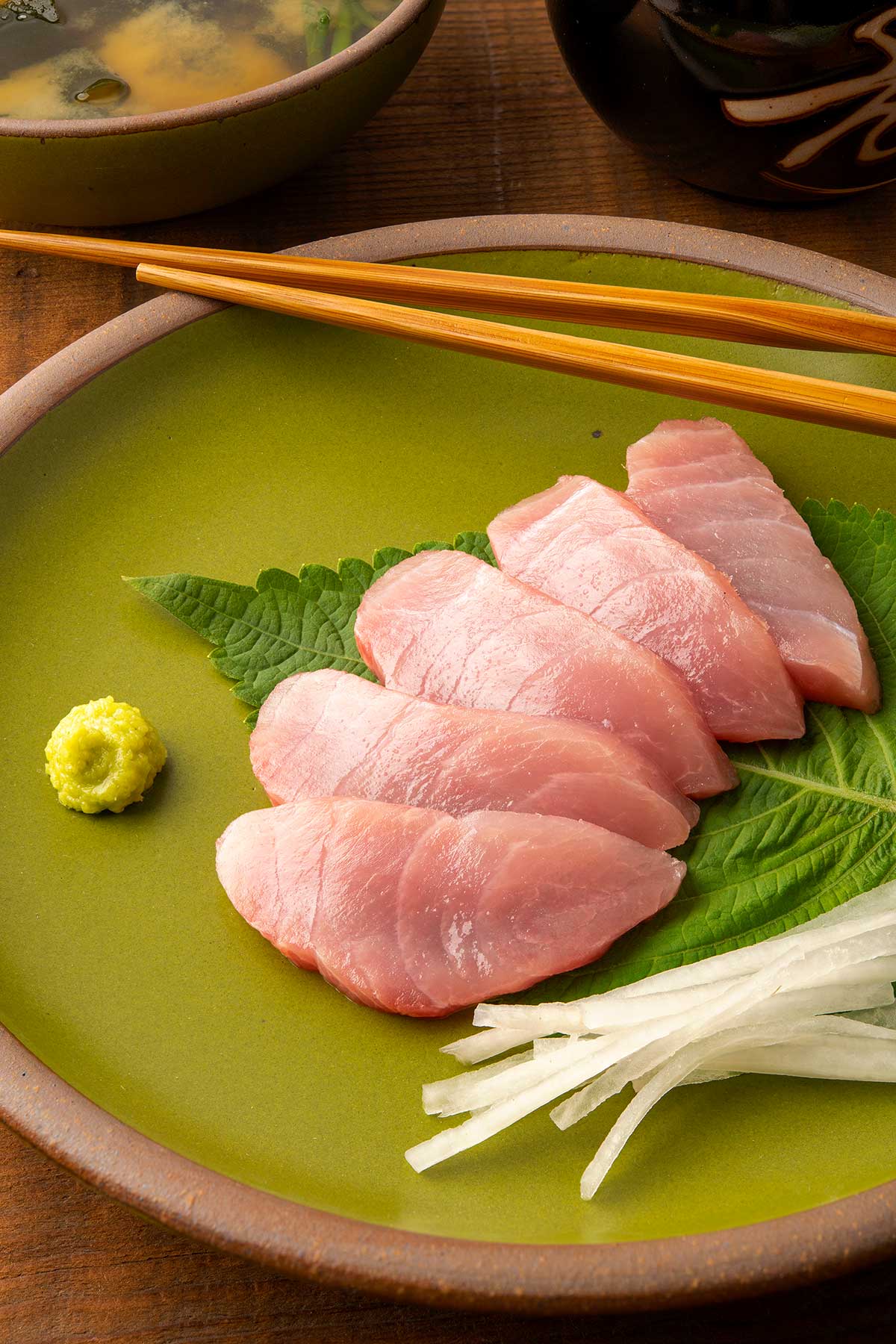Whenever I go to a sushi restaurant, I always order either hamachi sashimi or nigiri. Hamachi is Japanese yellowtail, and this fish is tailor-made for eating raw. Here’s how to make it, along with options for using other fish.
Sushi is amazing, but it is far harder to master than sashimi. Sushi has special rice and is formed into rolls or nigiri, skills that take years to master, while sashimi is basically slices of raw fish with rice on the side, or underneath.
In most places, your sashimi will come with wasabi, soy, shiso leaves, and often julienned daikon radish.
Of all the varieties of sushi fish, yellowtail is my favorite. Hamachi sashimi or nigiri are always a must-have because this fish is fatty, silky, mild and savory all at once. What’s more, yellowtail sashimi here in the United States is sustainable.
Hamachi and yellowtail, as well as kanpachi and hiramasa, are all jacks. Fast swimming, predatory fish with fatty, pink meat. Yes, there are subtle differences, but for the most part they are the same. The biggest difference is that if you get farmed hamachi sashimi, it will be fattier than wild American yellowtail.
As an angler, I catch yellowtail in Southern California. They are amazing fish, hard fighting and beautiful. The yellowtail we catch in the US and Mexico is Seriola ialandi, which, strictly speaking would make your yellowtail sashimi hiramasa sashimi in Japan. But like I said, they are very similar.
Yellowtail are almost never parasitized, so I feel comfortable about eating them raw, never frozen. But you should read my article on food safety for ceviche to get an idea about which fish you might want to do this with.
Chances are you will be buying your fish for hamachi sashimi, however. And in that case you can buy actual hamachi. I find it vacuum frozen in Asian markets, and if you have a really good Asian fish market, as we do here in Sacramento, they will fly it in from Japan.
Southern Californians can regularly buy yellowtail for yellowtail sashimi, and I’ve seen it a lot in Phoenix, too.
It is the fattiest part of the fish, making it naturally juicy, and there are two located in each yellowtail (one per side). Typically, Hamachi is grilled or broiled until the skin is crisp and the inside is just cooked through. You can easily scrape the flesh off the cartilage with chopsticks.

How to Cut Yellowtail Sashimi
Obviously hamachi sashimi is thinly sliced hamachi, right? Well, there’s a way to slice it right.
First, you need a long, very sharp knife. I have a sushi knife and I love it, but a long fillet knife that is as sharp as lightning will serve you well. In a pinch, your longest chef’s knife will be OK.
Why long? Because you cut fish for sashimi and sushi with one long slice where you draw the knife back towards you. Never saw through a piece of fish. Yellowtail are big fish (see picture above), so you need a long knife.
Always cut against the grain of the fish. If you cut with the grain, your hamachi sashimi will be nasty and chewy. Your best bet is to trim a block of yellowtail with an eye toward the eventual slices. In many cases, yellowtail smaller than what I caught in that picture above are easier to slice for sashimi.

Alternatives to Hamachi Sashimi
OK, I get it: You live in the Midwest or East or South. What to do? If you are inland, look for those Asian markets and go to the freezer sections. Ditto for the Northeast.
But from about Virginia to the Gulf of Mexico, you have amberjack, which is very close. And while amberjacks can get wormy, those worms are large and very visible, so if you don’t see them, they’re not there.
Wahoo is another excellent option, as are any of the tuna species.

BEST WAY TO EAT YELLOWTAIL | She Caught The Biggest Fish
FAQ
Is yellowtail a good fish to eat?
Can yellowtail be eaten raw?
Can you eat yellow tail skin?
Why is yellowtail so expensive?
What to eat with Yellowtail?
The lemon caper sauce is super flavorful and is an excellent addition to the mild-tasting yellowtail. Pair it with al dente orzo and spinach to complete this amazing dish! 6. Key Largo Onion Crusted Yellowtail Dig into this delicious onion-crusted yellowtail that’s super flavorful and a great addition to any lunch or dinner!
Is it safe to eat the tail of a fish?
Is it safe to eat the tail of a fish. The tails and fins from large fish can be smoked and boiled to help draw out meat and juices, but small fins can be fried or baked as a crispy snack, much the same way as skins.
Should you eat yellowtail fish?
If you’re looking to change up your weeknight dinner routine or reduce your meat intake, you may want to try yellowtail fish. Savory and delicious, this versatile fish is easy to prepare and always tasty. If you’d like to learn more about how to cook yellowtail fish, you’re in the right place.
